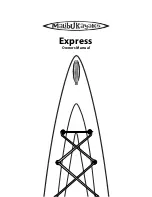
OPERATING INSTRUCTIONS
CAUTION
When braking, rid-
ers must brace themselves against
the deceleration force to prevent
from moving forward on the water-
craft and losing balance. The oper-
ator should always keep both hands
on the handlebars, and all passen-
gers should maintain a firm grip of a
handhold or the waist of the person
in front of them.
WARNING
Stopping distance will vary de-
pending on initial speed, load,
wind, number of riders, water con-
ditions, and the amount of braking
power commanded by the oper-
ator. Always adjust your riding
style accordingly.
When the watercraft slows to less than
14 km/h (9 MPH), braking mode ends
and reverse mode is engaged. Re-
lease the iBR lever once the watercraft
is stopped. Otherwise, a rearward
movement will be initiated.
CAUTION
As
the
watercraft
slows to a stop, the wake created
by the watercraft will catch up and
tend to push the watercraft forward.
Ensure there are no obstacles or
bathers in the direction of travel.
If the throttle lever is still pulled in
when releasing the iBR lever, the wa-
tercraft will accelerate forward after a
short delay. Acceleration will be pro-
portional to the throttle lever position.
WARNING
If forward acceleration is not de-
sired when the brake lever is re-
leased, release the throttle lever.
When at speed and the brake is first
applied, a plume of water will shoot up
in the air behind the watercraft which
may cause the operator of a following
watercraft to momentarily loose sight
of your PWC.
WARNING
– It is important to inform the
operator of a watercraft who
intends to follow in a convoy
formation, of the braking and
maneuvering capability of your
PWC, what the plume of water
indicates, and that a greater dis-
tance must be maintained be-
tween watercrafts.
– Be aware that other boats fol-
lowing or operating in close
proximity may not be able to
stop as quickly.
Braking in a Turn
Throttle must be applied for turning to
ensure directional control. However
braking can be initiated during a turn
using the iBR lever as previously de-
scribed. Get ready to maintain your
balance while the wake is crossing
your PWC.
CAUTION
As
the
watercraft
slows to a stop while braking in a
turn, the wake created by the water-
craft will catch up and tend to push
the watercraft sideways. Be pre-
pared to maintain balance as the
wake crossed the watercraft.
How to Use the Variable
Trim System (VTS)
The
variable
trim
system
(VTS)
changes the vertical position of the jet
pump nozzle to provide the operator
with a fast, effective system to com-
pensate for load, thrust, riding position
and water conditions. Correctly ad-
justed, it can improve handling, reduce
porpoising, and position the watercraft
at its best riding attitude to attain maxi-
mum performance.
_______________
93
Summary of Contents for Sea-Doo GTX
Page 9: ...SAFETY INFORMATION ________ SAFETY INFORMATION ________ 7...
Page 34: ...IMPORTANT ON PRODUCT LABELS EN 219905031 DEC LABEL 2 32 _______ SAFETY INFORMATION ________...
Page 48: ...PRE RIDE INSPECTION This page is intentionally blank 46 _______ SAFETY INFORMATION ________...
Page 49: ...WATERCRAFT INFORMATION _______________ 47...
Page 118: ...SPECIAL PROCEDURES This page is intentionally blank 116 ______________...
Page 119: ...MAINTENANCE ______________ 117...
Page 137: ...TECHNICAL INFORMATION ______________ 135...
Page 148: ...SPECIFICATIONS This page is intentionally blank 146 ______________...
Page 149: ...TROUBLESHOOTING ______________ 147...
Page 160: ...MONITORING SYSTEM This page is intentionally blank 158 ______________...
Page 161: ...WARRANTY ______________ 159...
Page 184: ...This page is intentionally blank 182 ______________...
Page 185: ...CUSTOMER INFORMATION ______________ 183...
Page 189: ...CHANGE OF ADDRESS OWNERSHIP ______________ 187...
Page 190: ...CHANGE OF ADDRESS OWNERSHIP This page is intentionally blank 188 ______________...
Page 191: ...CHANGE OF ADDRESS OWNERSHIP ______________ 189...
Page 192: ...CHANGE OF ADDRESS OWNERSHIP This page is intentionally blank 190 ______________...
Page 193: ...CHANGE OF ADDRESS OWNERSHIP NOTES ______________ 191...
Page 194: ...CHANGE OF ADDRESS OWNERSHIP NOTES 192 ______________...
Page 195: ......
















































